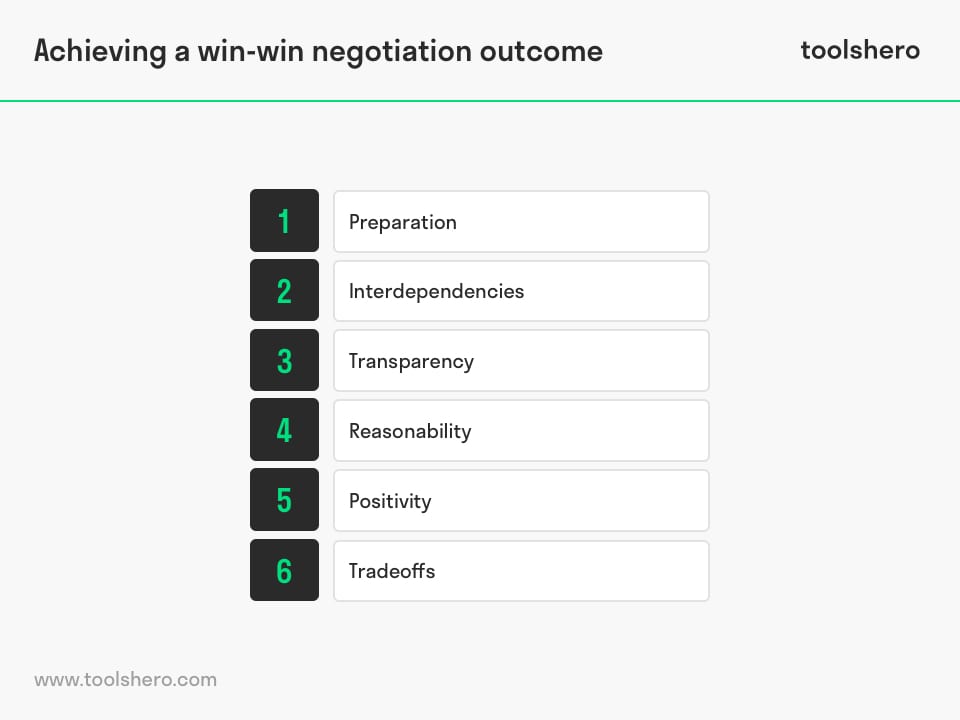Win Win Negotiation explained

Win win negotiation: this article provides a practical explanation of a win win negotiation. Next to what it is, this article also highlights how to achieve a positive outcome, the preparation and tips. After reading this article, you will understand the basics of this powerful management tool. Enjoy reading!
What is a Win-win negotiation?
Win-win negotiation is a negotiation style in which the interests of both parties are taken into consideration to end the discussion positively and gain maximum benefit. This negotiation style is for this reason, a discussion instead of a competition. Based on a conversation, parties exchange interests and see how help can be provided to build a long-lasting relationship.
If one of the parties would think to end the negotiation in a win-lose outcome, the likelihood is high that the other party feels that unfair practices occur, and the relationship might get damaged.
Win-win negotiation is achieved after both parties have taken into consideration each other’s interests. A crucial part of win-win negotiation is that the agreement cannot be further improved. In order to realize this outcome, both parties must think of creative solutions that benefit both.
However, it is not always easy to achieve a win-win negotiation. Sometimes one of the parties must make a tradeoff for which the party may be compensated for. Another difficulty could be to identify what the other party truly wants.
For instance, a furniture manufacturer who is negotiation with a potential customer that potentially order large amounts of products annually might think that the customer wants low prices because of the large volume.
However, it could be that this customer is seeking to do business with manufacturers who source their raw material from sustainable suppliers and assembly the final products in the most sustainable way, which the manufacturer cannot guarantee yet.
However, the potential buyer that the manufacturer approached knows that this manufacturer offers the best qualitative products. Requesting competitive biddings from other manufacturers might mean a loss of quality. For this reason, a win-win negotiation is preferred to find the best solution.
The previous example shows that this negotiation style is about satisfying the other party. It means that if one party has reached its benefit, it must still identify a way that also benefits the other party. Otherwise, the result would be considered as a win-lose negotiation. As explained previously, a win-lose situation is going to harm the long-term relationship of both parties.
Therefore, win-win negotiations could deliver more value with a lower risk compared to win-lose negotiations.
It requires excellent communication because this skill helps to satisfy both interests.
Communication is thus the most crucial element of win-win negotiation because the parties involved are discussing options, rather than playing with power. In this way, effective collaboration can be achieved, and both parties might end the negotiation successfully, which is that both parties are better off after the negotiation.
How to achieve a win-win negotiation outcome?
Achieving a win-win negotiation outcome can never be guaranteed. The goal of negotiation is to attempt to end the negotiation in a better position, but sometimes, parties achieve a win-lose or lose-lose outcome. For parties to achieve a win-win outcome, both must commit to preparing the negotiation process by analyzing what each party can control, and how this can benefit the other party.
In this way, the negotiation process could run smoothly, wherein both parties are involved. The most critical element of win-win negotiation is that the negotiation is not about winning or losing the negotiation, but both parties must discuss the possibilities that help to gain mutual benefits.

Figure 1 – Win-win negotiation achieve the outcome
Preparation of a win-win negotiation
Before anyone put a foot on the negotiation table, the first thing one should do is prepare the negotiation in advance. Despite that a discussion is required to realize a win-win negotiation, it is crucial to identify alternative solutions for personal circumstances but also the other party.
In this way, it will be clearer if potential solutions are indeed a win-win outcome or if a party can find better agreements elsewhere. One way to do this is to make use of the BATNA or RADPAC model.
Interdependencies
A way to identify if a negotiation can have a win-win outcome is to analyze if the parties have dependencies on each other. This is also part of the preparation. If an interdependency exists, it is easier to reach a mutual understanding of the situation. It is also most likely that both parties then understand the potential interest to collaborate and reach an agreement.
Transparency
It is important to note that it is good to be transparent in front of the opponent party, but it is even better not to be fully transparent. A vital element of this type of strategy is to provide just enough information to the opposition party to get driven to continue the negotiation.
It additionally helps to reduce pressures because not all cards have been put on the table yet. By utilizing this type of strategy, it enables the possibility to ask additional questions about what the other party genuinely is seeking for.
Reasonability
In order to realize a win-win negotiation, both parties need to be reasonable. This means that both parties must seek mutual benefits and to take into consideration the party’s requests and interests.
If for some reason, reasonable requests are continually being avoided or ignored, it looks more like a win-lose negation which can potentially damage the relationship. It is for this reason important that the negotiation has a mutual meaning and that both parties attempt to understand each other.
Positivity
In negotiating, it is always beneficial to be kind. It is, however, important to note that the positivity of being kind can sometimes be interpreted as the expectancy of reciprocity. If one of the parties think that this is the case, it can be seen as a weakness and influence the negotiation outcome.
However, on the contrary, if one of the parties tend to be too much self-centered, it could provoke the other party to use its dominant position. It is therefore crucial to be neutral in a win-win negotiation to prevent confusion between parties and maintain a positive relationship. It will additionally help to reach fair agreements.
Tradeoffs
To realize a this negotiation style, it many times happens that parties have to make tradeoffs to reach mutual agreements, as what is described in the first example of the furniture manufacturer and potential buyer. Another reason could be that both parties have different speculations about the future.
For instance, consider the following follow up on the example of the furniture manufacturer and the potential buyer: the potential buyer might believe that he sells fewer products if the manufacturer does not improve his sustainability practices, but the manufacturer might think that his operations will not harm the buyer’s business because he offers long-lasting qualitative products.
Moreover, the manufacturer might have a JIT production schedule and is depended on a fixed contract with his supplier. If the potential buyer is not able to sell the amount ordered, the manufacturer will be stuck with raw materials which cannot be stored in privately held warehouses. Both potentially have to make a tradeoff to reach an agreement
Tips to realize a win win negotiation
Ask questions
If the parties have executed research before going to the negotiation, it is still always best not to assume that one exactly knows what the other party is seeking for. The only way to find out what the other party wants in a win-win negotiation is to ask many questions.
Consider the following example of a car rental agency who wants to buy 10 new car model: As the car dealer might think that the buyer is majorly interested in the price, the buyer might be more concerned about the customer service, regarding maintenance, and the salvage value of different models. If the car dealer does not ask questions, the potential buyer likely approaches different sellers.
Diminishing conflicts
Next to asking the right questions, it is essential to prevent conflicts during negotiating. If a win-win negotiation must be realized, it is best to solve a conflict immediately as soon as it arises.
It does not mean that disputes always occur, but there is still a possibility that a disagreement occurs. Ignoring a dispute would look like one of the parties is interested in a win-lose negotiation and could substantially damage the relationship. For this reason, if one identifies a conflict, try to seek for alternative solutions actively.
Sometimes, it happens that no solution can be found immediately. In this scenario, it might be a good idea to temporarily to stop the negotiation and continue it on another day. It will give both parties time to identify creative alternative solutions.
Dealing with win-lose negotiations
If one of the parties is interested in a win-lose negotiation instead of win-win negotiation, it will be noticeable quickly.
The party engaged in win-lose negotiation tries to do anything that interests him or her solely.
If this type of situation occurs, it is best to confront the party of its practice and that it is not welcomed. It is in stage still possible to communicate that a win-win outcome is expected. From this point, the negotiation can continue when the behavior changes. Otherwise, it is an option to consider cancel the negotiation and consider the BATNA model.
Now it’s your turn
What do you think? Do you recognize the explanation of win-win negotiation? Have you experienced win-win negotiations? Do you agree with the tips or do you have other tips or additions you would like to share?
Share your experience and knowledge in the comments box below.
More information
- Brams, S. J., & Taylor, A. D. (2000). The win-win solution: guaranteeing fair shares to everybody. WW Norton & Company.
- Dietmeyer, B., & Kaplan, R. (2004). Strategic Negotiation: A breakthrough 4-step process for effective business negotiation. Dearborn Trade Publishing.
- Falcão, H. (2012). Value negotiation: How to finally get the win-win right. FT Press.
- Gruenbacher, P. (2000, September). Collaborative requirements negotiation with EasyWinWin. In Proceedings 11th International Workshop on Database and Expert Systems Applications (pp. 954-958). IEEE.
- Ilich, J. (1973). The art and skill of successful negotiation. Prentice-Hall.
- Klein, M., Faratin, P., Sayama, H., & Bar-Yam, Y. (2003). Negotiating complex contracts. Group Decision and Negotiation, 12(2), 111-125.
- McDevitt, B. (2004). Negotiating the syllabus: a win-win situation?. ELT journal, 58(1), 3-9.
- Smith, M. L. (1992). Planning your negotiation. Journal of Management in Engineering, 8(3), 254-260.
- Warner, M. (2001). Complex problems, negotiated solutions. ITDG publishing, London.
How to cite this article:
Zeeman, A. (2019). Win Win Negotiation. Retrieved [insert date] from Toolshero: https://www.toolshero.com/management/win-win-negotiation
Published on: 11/08/2019 | Last update: 08/22/2023
Add a link to this page on your website:
<a href=”https://www.toolshero.com/management/win-win-negotiation/”>Toolshero: Win Win Negotiation</a>










